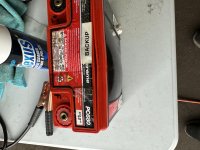MacCool
Well Known Member
I run two PC680's on the firewall. One of them is 3 years old, the other is over 6 years old. Two separate contactors on a split master switch, but they are wired in parallel. The electrical system normally will run from either or both master switches on. The (single) alternator charges both.
The other day, after a normal flight with engine off, I hit the right master switch in order to put the flaps down....all I got was "click click click". I turned the other master switch on and everything worked normally. I pulled the cowl, checked voltages directly, and the three-year-old battery read 13.8 volts, the 6 year old battery read 10.1 volts. Load testing showed complete failure of the older battery. I removed it and noted that it was quite swollen. I have a new one coming from Amazon.
Normally when in the hangar, the batteries are both kept on an Odyssey 6-amp charger (with "desulfation" mode), charged in parallel.
Is this a typical failure mode for an old, work-out AGM battery? I know that most swollen batteries are due to overcharging, and I gather that that is more likely to happen with age, but I'm wondering if I should be looking harder at the charging circuit, or consider a different float charging method. During flight, EMS indicates normal volts and normal amps.
The other day, after a normal flight with engine off, I hit the right master switch in order to put the flaps down....all I got was "click click click". I turned the other master switch on and everything worked normally. I pulled the cowl, checked voltages directly, and the three-year-old battery read 13.8 volts, the 6 year old battery read 10.1 volts. Load testing showed complete failure of the older battery. I removed it and noted that it was quite swollen. I have a new one coming from Amazon.
Normally when in the hangar, the batteries are both kept on an Odyssey 6-amp charger (with "desulfation" mode), charged in parallel.
Is this a typical failure mode for an old, work-out AGM battery? I know that most swollen batteries are due to overcharging, and I gather that that is more likely to happen with age, but I'm wondering if I should be looking harder at the charging circuit, or consider a different float charging method. During flight, EMS indicates normal volts and normal amps.





